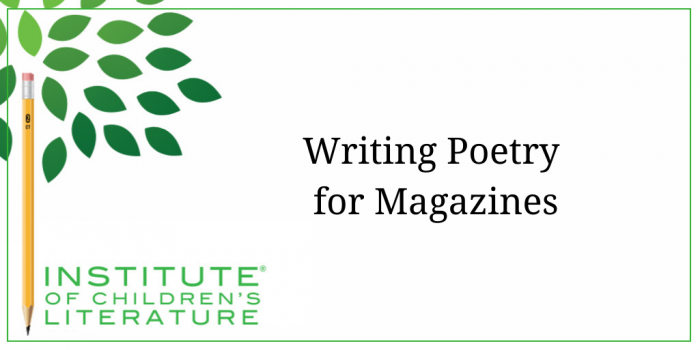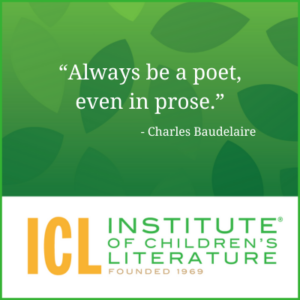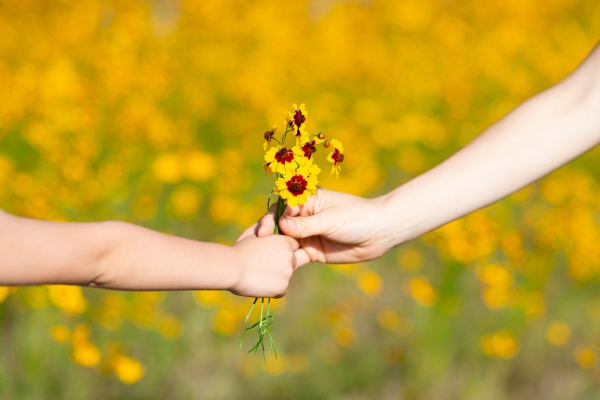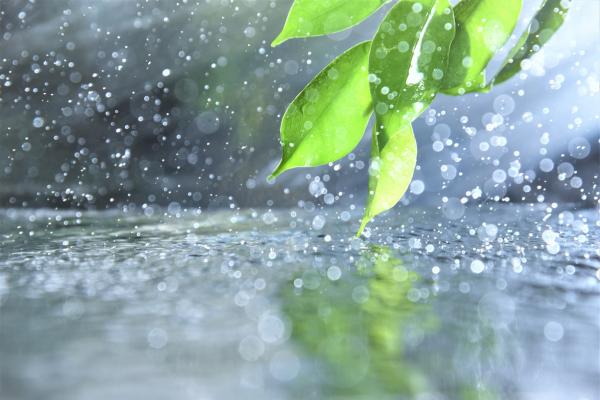1000 N. West Street #1200, Wilmington, DE 19801
© 2024 Direct Learning Systems, Inc. All rights reserved.

Magazines, both print and online, tend to be some of the very best opportunities for children’s poets to break into print. Poetry collections are a tough sell to book publishers, so magazines are the point where most children encounter poetry, especially poetry written today. But what is required of children’s poetry for magazines?

1. Something to see. Children’s poetry tends to be full of very concrete images that are a bit unusual in perspective. If you see things a little oddly or regularly make unique comparisons, poetry allows you to share that ability with the world.
2. Something happening. Children are active creatures, and they tend to require action in story and in poetry. You don’t find a lot of deep, silent introspection in children. It’s not that they don’t think about things, but they do it in bursts, not musings.
3. Something to feel. Because telling new poets that a piece must have emotional depth can inspire a flurry of abstractions about emotion, know that “something to feel” doesn’t mean lists of emotions. Instead, a poem needs to produce a feeling in the reader. A poem has mood. The mood may be bright and light and totally silly. The mood may be loving and warm and snuggly. Or the mood may be sleepy. Or regretful. Or spooky. But you’re almost certain to have mood in your poem.
When you see an object – how do you see it? Look at a dandelion, for example. What do you see? A wildflower? A weed? If “weed” is the strongest thing you feel, think a moment about weeds. Why do weeds upset us so? They never seem to give up as they battle us for ownership of the lawn. That tenaciousness might remind us of upright soldiers in bright yellow hats. See how that works?

Yellow buttons – have you ever noticed how mowed lawns produce these flat yellow buttons where the dandelions bloom nearly flush with the ground to avoid the mower? They remind me of green clothes covered in bright gold buttons. I actually sold a poem with this image.
Snow white kittens – When the dandelion is ready to puff away, they’re so fluffy and white. And since the name includes “lion” – I’ve often thought they were less lion than curled up white kitten, waiting to burst into action with a puff.
Do you see how either of these images could grow into a poem?
In this instance, I picked dandelions as an example because they are seasonal, and seasonal poems are incredibly popular with magazines. Make a list of some common seasonal things that kids are likely to encounter. The items can be natural like puddles, butterflies, and cherry blossom petals, or the items might be man-made such as dyed eggs, sugar cookies, mashed potatoes, and rain boots. Consider the item intensely for a while. Try brainstorming a possible poem for each item through the different ways you can see each thing? Discard the most common ideas that come to mind and keep pondering until you come across something really weird, then you’ve got a potential keeper. In a poem called “Stone Bench in an Empty Park,” Jane Yolen wrote about the brightly colored ice cream wrappers in the overflowing park trash cans. She imagined flowers blooming – now that’s an unusual perspective!
 Something Happening
Something HappeningLooking is not quite enough for a children’s poem – they nearly always contain movement as well. Kids are kinetic, and they like their poetry that way also. The movement can be simple or silly, but there is nearly always movement. Again if you take your list of seasonal items and consider movement for each, you might come up with something silly, like a mother and child giving eggs bright colored baths to dress them for an Easter outing. Or perhaps your dandelion soldiers crouch and sway to dodge their greatest foe, the mower. Or your puddle poem might have children stomping out a splashy spring song in their yellow rain boots. When you see seasonal things in new ways, you can view movement related to them in new ways too.
Poetry tends to be moody. Mood doesn’t happen because you announce it, but because you portray it though the unique way of looking at common things and the action. Most of my children’s poetry tends to be rambunctious. It’s light and sometimes a little silly. A light mood is quite popular in poetry for magazines, but it is not all you see. Some poetry celebrates seasonal activities with family and has a homey, cozy mood. Some poetry for elementary-aged readers may look at serious things in a way that can be uncomfortable or even a bit scary. Great poets will often take a poem to deeper places. For example, in the Jane Yolen poem I mentioned before, “Stone Bench in an Empty Park,” the mood was contemplative, but still filled with the bright, concrete imagery of wrappers being like flowers.
So as you dabble in children’s poetry, keep in mind that magazines are often the best opportunity for publication as long as you craft poems that give the reader something to see, something that moves, and something to feel. Do it all by showing and not telling, and you’ll end up with a poem that delights children, parents, and picky editors. Not only that, but you’ll strengthen your own writing skills with every poem you craft. So, don’t be scared, jump right in, and begin your poetry adventure.
With over 100 books in publication, Jan Fields writes both chapter books for children and mystery novels for adults. She’s also known for a variety of experiences teaching writing, from one session SCBWI events to lengthier Highlights Foundation workshops to these blog posts for the Institute of Children’s Literature. As a former ICL instructor, Jan enjoys equipping writers for success in whatever way she can.
1000 N. West Street #1200, Wilmington, DE 19801
© 2024 Direct Learning Systems, Inc. All rights reserved.
1000 N. West Street #1200, Wilmington, DE 19801
© 2024 Direct Learning Systems, Inc. All rights reserved.
1000 N. West Street #1200, Wilmington, DE 19801
© 2024 Direct Learning Systems, Inc. All rights reserved.
1000 N. West Street #1200, Wilmington, DE 19801
© 2024 Direct Learning Systems, Inc. All rights reserved.

1000 N. West Street #1200, Wilmington, DE 19801
© 2025 Direct Learning Systems, Inc. All rights reserved.

1000 N. West Street #1200, Wilmington, DE 19801
©2025 Direct Learning Systems, Inc. All rights reserved. Privacy Policy.
6 Comments